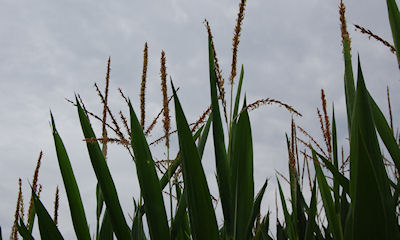
How can corn growers know if their corn has excess nitrogen? Or not enough to take advantage of the field’s yield potential this year? Did you apply the right amount of nitrogen for your corn crop this year? Those were questions often overheard in conversations between farmers and fertilizer dealers at soil testing and other crop nutrient-related exhibits at last week’s Farm Progress Show at Boone in central Iowa.
“A crop may still look good if there is excess or inadequate nitrogen,” said Jim Friedericks, AgSource Laboratories’ outreach and education adviser. “Even though there are no visible signs, your yield may have been impacted.”

VALUABLE TOOL: Testing cornstalks for nitrate is a very worthwhile way to tell if corn had excess or inadequate nitrogen during the growing season. Stalk samples need to be taken at the right time and sent to a lab for testing.
Cornstalk testing can save money on N fertilizer application
Studies at Purdue and Iowa State University show that the nitrogen status of a corn crop can be best assessed by measuring nitrate concentrations in the lower portion of cornstalks at the end of the growing season. He noted, “Their research has proven this is a very viable tool for crop producers.��”
Friedericks says cornstalk testing can save you money on fertilizer applications by showing you which fields have excess N uptake—which fields have a high nitrate concentration in the stalks at the end of the growing season. Because of the potential positive environmental impacts for doing this testing, there are financial incentive programs to help pay for testing. Contact your local Natural Resources Conservation Service (NRCS) or local ISU Extension office for more information.
Take nitrogen gains or losses into account when making decisions
In addition to what the crop uses for growth, there are natural gains and losses for nitrogen that must be taken into account, says Friedericks. Nitrogen loss can occur due to leaching, volatilization and microbial activity, which depends on the soil temperature, oxygen, moisture and residue.
Natural nitrogen gains primarily depend on microbial activity, but there is also atmospheric fixation; rain carrying nitrogen to the soil during lightning storms can contribute up to 15 pounds of nitrogen per acre per year, he says. Biological fixation by nodules on legumes also provides nitrogen. Mineralization is microbes decomposing plant residue and organic matter to release nitrogen. Combined, they can release up to 100 pounds of nitrogen per acre per year under ideal conditions.
“Nitrogen gains can be significant,” notes Friedericks. “Thus, after forecasting the natural gains of atmospheric fixation, biological fixation, nitrification and mineralization, it is wise to plan commercial nitrogen fertilizer applications accordingly.”
You should also test soil for P and K, and test manure
“Properly identifying nutrient levels can help you make the best management decisions,” notes Friedericks. The cornstalk nitrate test shows how the N applications of the past season met crop needs. “We recommend testing the soil regularly and testing manure before it is applied in the fall because each analysis can help you better plan for next year.”
He says it is very important to get samples to the lab as soon after collecting them as possible. That is especially the case for the stalk samples collected for the late-season cornstalk nitrate testing.
You may have to sample cornstalks earlier than usual in 2016
In many areas of the Upper Midwest this year the growing season is seven to 10 days ahead of average and you may have to do the cornstalk nitrate testing earlier than in the past. “Take samples based on when the black layer forms on the tip caps of the kernels. You need to start watching for that black layer now.” He adds, “Also, keep in mind that if you are testing stalks for cornstalk nitrate concentration, if you wait too long and the corn is too dry when you collect the stalk samples for the test, you may not get useful results.”
AgSource is a leader in agricultural and environmental laboratory analysis and information management services. A subsidiary of Cooperative Resources International, AgSource provides services to clients in the United States and across the globe. Learn more about cornstalk testing at agsource.com/CornStalkNitrogen.
How to sample cornstalks for end of season nitrate test
Friedericks offers the following recommendations for proper collection of stalk samples to send to the lab for the stalk nitrate test.
When to sample: Take samples one to three weeks after black layers have formed on 80% of the kernels of most ears.
What to sample: Cut stalk segments eight inches long. Take stalk segments from between 6 and 14 inches above the soil. Avoid damaged stalks and be sure to remove sheaths.
Amount of sample: Within an area not larger than 10 acres, 15 stalk segments should be randomly collected. Together, these stalks form one 'composite' sample. Areas of differing soil types or management should be sampled separately.
Shipping: Place stalks in a paper bag. Do not use plastic bags! Ship samples as soon as possible. Refrigerate if delay in shipping is one or more days. Do not freeze.
About the Author(s)
You May Also Like




